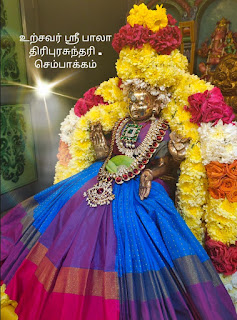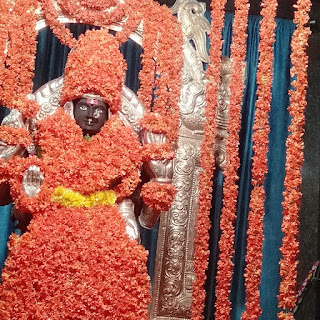जन्म-मृत्यु-जरा-तप्त-जन-विश्रान्ति-दायिनी (851)
Janma-mṛtyu-jarā-tapta-jana-viśrānti-dāyinī
Living beings are afflicted by birth, old age and ultimate death. She provides solace to such beings. Solace is in the form of salvation.
सर्वोपनिषदुद्घुष्टा (852)
Sarvopaniṣadudguṣṭā
She is glorified in all the Upaniṣads. ud is used for implying superiority in place, rank or power and guṣṭā means announcing. This nāma says that all the Upaniṣads announce Her glory.
शान्त्यतीत-कलात्मिका (853)
Śantyatīta-kalātmikā
Śantyatīta is a kāla or time factor. Śantyatīta means transcending peace (Śanti). This is the stage of jīvanmukti, the stage where avidyā has been totally destroyed by acquiring Supreme knowledge. However, a trace of ignorance still prevails in this stage to undergo pains or pleasures of the balance in karmic account. The next stage is liberation. Transcending the jīvan mukti stage is known as Śantyatīta kalā. She is said to be in that form.
गम्भीरा (854)
Gambhīrā
Gaṁ (गं) is Gaṇapati bīja, bhī (भी) means fear and ra means drives away. The fear of Her devotees are driven away by making them worship Lord Gaṇeśa whose bīja is gaṁ.
गगनान्तस्था (855)
Gaganāntasthā
The One who permeates the space.
Gagana means the ākāś.
गर्विता (856)
Garvitā
She is proud.
गान-लोलुपा (857)
Gāna-lolupā
She is fond of songs.
कल्पना-रहिता (858)
Kalpanā-rahitā
Kalpana means formation of ideas and rahita means absent. She is devoid of approximations, as She is the endowment of Reality.
काष्ठा (859)
Kāṣṭhā
She's the highest goal attainable by anyone . She's the Brahman and there's nothing higher than the Brahman.
अकान्ता (860)
Akāntā
She is the destroyer of sins.
कान्तार्ध-विग्रहा (861)
Kāntārdha-vigrahā
She has half the body of Her husband Śiva. Kāntā means Śiva. This form is known as Ardhanārīśvara form, half-male and half-female.
कार्य- कारण-निर्मुक्ता (862)
Kārya- kāraṇa-nirmuktā
She is not subjected to cause and effect, as She's the Brahman
काम-केलि-तरङ्गिता (863)
Kāma-keli-taraṅgitā
She overflows with joy in the presence of Śiva. Kāma means Śiva.
कनत्-कनक-ताटङ्का (864)
Kanat-kanaka-tāṭaṅkā
She is wearing glittering ear studs made of shining gold.
It is said that sun and moon are Her ear studs.
लीला-विग्रह-धारिणी (865)
Līlā-vigraha-dhāriṇī
She takes different forms, just like child's play.
अजा (866)
Ajā
She is unborn. She's without birth and beginning.
क्षय-विनिर्मुक्ता (867)
Kṣaya-vinirmuktā
She is free from decay. Decay here means death. When there is no birth, there is no death. Brahman is beyond birth and death as everything originates from Him.
मुग्धा (868)
Mugdhā
She is beautiful. Mugdhā also means innocent. Innocence is a quality that lacks intent to injure others.
Quality of innocence makes Her beautiful.
क्षिप्र-प्रसादिनी (869)
Kṣipra-prasādinī
Kṣipra means quickly.
If She is worshipped, salvation is attained in this birth itself.
अन्तर्मुख-समाराध्या (870)
Antarmukha-samārādhyā
She is worshipped by those who look within. She has to be realized by internal search and exploration. This is based on the theory that Ātman resides within.
बहिर्मुख-सुदुर्लभा (871)
Bahirmukha-sudurlabhā
Previous nāma conjoins with this nāma to declare the process of Self-realisation. She is very difficult to attain for those who are not able to look within. Mind is the prime factor to look within. Unless senses are controlled, it is difficult to control the mind. This nāma says that She cannot be attained only by external means.
त्रयी (872)
Trayī
Trayī means three and here it refers to three Veda-s, Rig, Yajur and Sāma. In fact, She is revered as the mother of Veda-s , Veda jañanī. This nāma says that She is in the form of three Veda-s.
त्रिवर्ग-निलया (873)
Trivarga-nilayā
She prevails in all three factors of time, past, present and future.
त्रिस्था (874)
Tristhā
There are many triads. Past, present and future; Brahma, Viṣṇu and Rudra; Creation, sustenance and dissolution; the three letters of ॐ a, u and m; the three types of karma-s prārabdha, sañcita āgāmya or kriyamāṇa; three guṇa-s – sattva, rajas and tams; icchā, jñāna and kriyā śaktī-s, etc.
She is present in all the triads.
त्रिपुरमालिनी (875)
Tripuramālinī
Tripuramālinī is the presiding deity of sixth āvaraṇa of Śrī Cakra, known as sarva rakṣāakara (the Supreme Protector). She is assisted by other yogin-s known as nirgarbha-yogini-s (not born from wombs). This āvaraṇa represents sṛṣṭi (creation).
Mālini is also known as wife of Kāma (Śiva). Tripura could also mean three primary stages of consciousness (awake, dream and deep sleep). In this context this nāma means that She rules over the initial three stages of consciousness. The ultimate level of consciousness is Śiva.
निरामया (876)
Nirāmayā
She is devoid of diseases. Maya means medical treatment for diseases. She is beyond body and mind. She is the remedy to all diseases .
निरालम्बा (877)
Nirālambā
She is without support and everything is supported by Her.
स्वात्मारामा (878)
Svātmārāmā
She rejoices in Her own Self.
सुधास्रुतिः (879)
Sudhāsrutiḥ
She is the cause for the divine nectar that flows down the upper palate and throat when one enters the blissful state.
सम्सार-पङ्क-निर्मग्न-समुद्धरण-पण्डिता (880)
Samsāra-paṅka-nirmagna-samuddharaṇa-paṇḍitā
She rescues Her devotees who are entangled in saṃsāra. Saṃsāra means materialistic life.
यज्ञ-प्रिया (881)
Yajña-priyā
She is fond of sacrifices.
यज्ञ-कर्त्री (882)
Yajña-kartrī
Yajña means sacrifice. In an yājña, the (yajamanan) performer is considered as Śiva Himself. His wife is Śaktī. She is in the form yajamānā’s wife.
यजमान-स्वरूपिणी (883)
Yajamāna-svarūpiṇī
She is in the form of yajamāna who directs sacrificial rites.
धर्मा-धारा (884)
Dharmā-dhārā
She is in the form of Dharma.
धनाध्यक्षा (885)
Dhanādhyakṣā
Dhanādhyakṣā is Kubera, the lord of wealth. She is said to be the Lord of wealth.
धन-धान्य-विवर्धिनी (886)
Dhana-dhānya-vivardhinī
She is the increaser of wealth and granary. This happens automatically for Her true devotees.
विप्र-प्रिया (887)
Vipra-priyā
Vipra means learned. She is fond of the learned and wise.
विप्र-रूपा (888)
Vipra-rūpā
She is the embodiment of knowledge itself.
विश्व-भ्रमण-कारिणी (889)
Viśva-bhramaṇa-kāriṇī
Viśva means entirety and in this context all the universes or brahmāṇḍa-s . She is always referred as akhilāṇḍakoṭi brahmāṇḍa nāyakī अखिलाण्डकोटि ब्रह्माण्ड नायकी which means that She is the creator of number of universes.
विश्वग्रासा (890)
Viśvagrāsā
She devours universes. This refers to Her act of dissolution.
विद्रुमाभा (891)
Vidrumābhā
Vidrumā means coral coloured. Coral is red in colour, which is Her complexion. Vidrumā also means tree of knowledge.
वैष्णवी (892)
Vaiṣṇavī
She is in the power of Viṣṇu. Viṣṇu and Lalitāmbikā are said to be brother and sister.
विष्णुरूपिणी (893)
Viṣṇurūpiṇī
She is the form of Viṣṇu.
अयोनिः (894)
Ayoniḥ
Yoni is generally used to indicate the divine procreative energy, also known as the source of origin. A-yoni means She is without origin.
योनि-निलया (895)
Yoni-nilayā
She is the Creator.
कूटस्था (896)
Kūṭasthā
Kūṭasthā means engaging in ignorance. This nāma says that She abides in ignorance!
कुल-रूपिणी (897)
Kula-rūpiṇī
Kula means noble, eminent or race or chief, etc. Kula also means mūlādhāra cakra. She's present in all these forms.
वीरगोष्ठी-प्रिया (898)
Vīragoṣṭi-priyā
Vīra means overpower or subdue. Those who have overpowered their senses are known as warriors or vīra. Conquering senses is like fighting in a battle field. The victorious ones are called vīragoṣṭi (group of warriors). She's fond of such warriors.
वीरा (899)
Vīrā
She is valorous.
नैष्कर्म्या (900)
Naiṣkarmyā
She transcends karma. She is not afflicted by karma-s.
नाद-रूपिणी (901)
Nāda-rūpiṇī
Shakthi is known as Nāda, the unmanifest from of sound. ॐ represents this nāda form of Śabda Brahman. Again, She is the Śabda Brahman, the creator of the universe.

















No comments:
Post a Comment